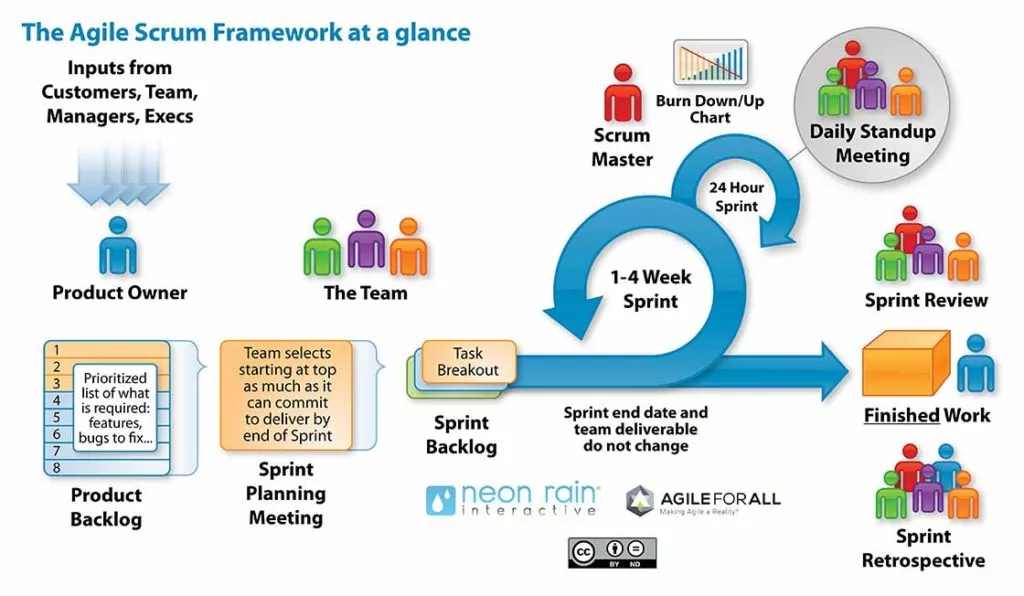
In the world of Agile project management, there are a number of approaches to choose from. Teams may apply a specific Agile framework based on the project type, length, scope, or requirements. For teams who need to deliver quickly and continuously, the Scrum methodology can be a solid way to apply Agile principles while delivering value to the customer or end-user. But what is Scrum, and what are the different processes, principles, and values needed to uphold this framework?
အောက်ဖက်စာမျက်နှာဖက်ကို နှေးနှေး လေး Article အောက်ဆုံးရောက်တဲ့အထိ သွားပေးပါ။
အနဲဆုံး ၃၀-၆၀ စက္ကန့် ခန့် ဒီ စာမျက်နှာ ပေါ်တွင် ခဏနေပေးပါ။
If you’re new to Agile product development, read on because this guide will cover the Scrum methodology, Scrum principles, the main Scrum roles, and some of the benefits of choosing Scrum. We’ll begin with the definition of Scrum.

What is Scrum?
Scrum is a project management framework that provides a structure for fast-paced Agile teams to prioritize, manage, and execute work. This structure helps teams deliver value to customers, collaborate often and effectively, and solve pressing development issues. Scrum also facilitates an improved product delivery process.
Scrum ceremonies, artifacts, and roles ensure a structured approach to Agile project management. Each meeting, role, and Scrum artifact acts as a piece of the puzzle, enabling teams to set priorities, continuously deliver, and problem-solve efficiently.
Because of this, Agile Scrum product development is popular. According to a report from the project management institute, 55% of project managers confirmed that they use Scrum at least some of the time.
Scrum principles
Scrum’s principles serve as guidelines for executing the Scrum methodology. They ensure that there is an understanding of the processes and dynamics of a Scrum environment. It is the Scrum master’s responsibility to uphold Scrum principles and values. Here’s a breakdown of the six Scrum principles.
1. Empirical process control
To remain effective, agile, and able to respond to change, Scrum relies on empirical process control. This means that the entire Scrum process is ruled by transparency, inspection, and adaptation.
2. Self-organization
The Scrum method encourages a level of independence from the Scrum team. When Scrum teams are described as “self-organizing,” this simply means that they manage their own tasks, solve problems independently, and are accountable to themselves and each other — rather than an outside manager.
3. Time-boxing
Time-boxing is a practice where a fixed amount of time is allocated for certain activities or objectives. Time-boxing allows for activities to be completed in an optimal time frame without running too long. Time-boxing is ideal for setting time frames around activities like sprint planning and sprint retrospectives.
4. Value-based prioritization
To achieve value-based prioritization, items in the product backlog are constantly updated based on their value and importance to the end-user and stakeholders.
5. Iterative development
Because of its ongoing sprints, the objectives in product development are consistently reviewed and updated to create the best quality product and delivery process.
6. Collaboration
Scrum teams collaborate frequently and, sometimes, at great length. Daily standup meetings are an opportunity to collaborate and problem-solve, as are sprint reviews and retrospectives.
Roles on an Agile Scrum team
As mentioned earlier, the Scrum team’s goal is to build a quality product for the end-user. But who does the Scrum team consist of? The Scrum team consists of three roles. The product owner, Scrum master, and development team. Here’s a breakdown of each Scrum role and what they do.
The product owner
The product owner is in charge of maximizing value. That means they’re not just concerned about the day-to-day work on the product or planning the sprint itself. Their job is to ensure that the interests of the stakeholders and customers are represented through the prioritization of the product backlog. The product owner also ensures that the deliverables meet evolving requirements.
The Scrum master
The Scrum master is the person in charge of guiding the development team to be more self-sufficient. The Scrum master acts as a facilitator, ensuring all team members adhere to the principles and processes of the Agile Scrum methodology.
As a guide, the Scrum master encourages the team to think of creative ways to tackle pressing impediments. This is achieved by constantly asking the right questions that will nudge them to come up with solutions.
The development team
The development team is the brains behind the process. While they work with the support of the product owner and Scrum master, they have the necessary technical skills to build and deliver a great product.
Ideally, the development team consists of cross-functional team members, including QA testers, designers, and developers. To ensure optimal performance, the development team must observe Scrum best practices and rules during product development.
Scrum methodology overview: What’s involved?
Many teams choose Scrum because it is ideal for project objectives that tend to change over time. Because of this, there’s a need for constant feedback and iterations at every stage of the product development.
Ideally, the team applies Scrum processes based on a set of principles and values that must be acknowledged during the software development life cycle.
Scrum methodology includes:
- The product backlog
- Sprint planning
- A series of sprints that lead to a product increment and then a working product
The Product backlog
The product backlog includes the necessary features and functionalities that need to be added to the software. Because the product owner sets the foundation of the product development, they create and groom the backlog by adding and prioritizing items. The product owner evaluates these items by asking questions such as “what impact does this feature create in the development process?”, What are the risks involved?”, “What are the costs involved?” Answering these questions helps outline the clear value of each item in the backlog.
Sprint planning
After creating the product backlog, the team begins sprint planning. This process is where teams go through the product backlog to figure out how to achieve the most important objectives and ensure they don’t spread themselves too thinly. After this, the team can get a better understanding of how the product development will progress.
Sprints
During sprints, the Scrum team completes the goals and objectives outlined for that particular time frame. Ideally, a sprint should last 1 – 4 weeks — but shouldn’t take more than a month. During the sprint, the Scrum team attends a daily standup meeting with the product owner and Scrum master. This is where they discuss what they are working on that day and talk through any issues or impediments they are experiencing. It’s important to note that no changes must occur when a sprint is in progress. This is to ensure that the team can meet the sprint goal without issue.
Sprint review
At the end of every sprint, the Scrum team — including the product owner and Scrum master — gather together to review the sprint, including what went well, what was completed, and what the updated backlog will look like. A product demo may also be on the agenda.
Here, the product owner will validate the sprint work. Once this phase ends, the cycle begins again, starting with the product backlog, sprint planning, next sprint, and a product increment.
In summary, the Scrum methodology is a learning and disciplinary process that enables the Scrum team to identify ways to improve and deliver the best quality product to the end-user.

အနဲဆုံး ၃၀-၆၀ စက္ကန့် ခန့် ဒီ စာမျက်နှာ ပေါ်တွင် ခဏနေပေးပါ။
ကြော်ညာတွေ ကလစ်(နှိပ်ရန်) မလုပ်ခင် ၂၀ စက္ကန့် လေး ပြည့်အောင် ဒီစာမျက်နာမှာ နေပေးပါ။
အောက်ကိုဆက်သွားပါ
Benefits of the Scrum methodology
Scrum provides tremendous benefits to organizations, product development teams, and individuals. Here are some of the benefits of Scrum:
Timely prediction
By using the Scrum framework, you can estimate the average speed of the team. As a result, it is possible to estimate when a certain feature in the product backlog will be delivered.
Improved team morale
The Scrum method involves a concerted effort on the part of each team member. Being part of a self-organizing team enables people to be proactive, innovative, and focused. The support of a Scrum master is also vital for team morale because they guide the Scrum team, remove all impediments, and work towards improving the performance of the team
Better quality product
Scrum provides the framework for collaboration and continuous improvement. Activities like sprint retrospectives and sprint reviews ensure the team has a chance to reflect and improve their processes.
Increased customer satisfaction
The primary objective of the Scrum team is to provide value for the end-user. This is achieved by:
- Keeping all stakeholders and customers in the loop throughout the project development
- Having an experienced product owner that understands the scope of the project development cycle
- Constantly updating and re-prioritizing the project backlog as feedback is provided
In Agile software development, the Scrum framework encourages better collaboration and understanding amongst team members.
When a team follows Scrum’s principles and guidelines, they create the opportunity to learn, adapt and be more independent at every stage of product development.

အနဲဆုံး ၃၀-၆၀ စက္ကန့် ခန့် ဒီ စာမျက်နှာ ပေါ်တွင် ခဏနေပေးပါ။
ကြော်ညာ တွေဆိုတာ အောက် ပြတဲ့ ဟာတွေဖြစ်တယ်။ ကလစ်ပြီး သူတို့ website မှာ အနဲဆုံး ၁ minute လောက်နေပေးပါ
ကြော်ညာ 2
++++++++++++++
